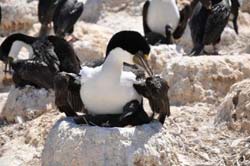'Superbird' stuns researchers

Imperial cormorants from Punta León in Argentina.<br>Credit: Wildlife Conservation Society<br>
A team of researchers from the Wildlife Conservation Society (WCS) and the National Research Council of Argentina recently fitted a South American sea bird called an imperial cormorant with a small camera, then watched stunned as it became “superbird” – diving 150 feet underwater in 40 seconds, feeding on the ocean floor for 80 seconds where it eventually caught a snakelike fish, before returning to the surface 40 seconds later.
This is the first time researchers have been able to watch first-hand the amazing feeding techniques of these fascinating birds, which occur off the coast of Argentina.
The footage shows the cormorant briefly on the surface before diving for the bottom. The camera is attached to the bird's back, so the view is of its head as it pumps its feet to swim deeper. When it finally reaches the ocean floor, it explores a vast area searching for food. It eventually finds an elongated fish, which it brings to the surface to eat.
The footage came from Punta León in Patagonia, Argentina, a coastal protected area supporting more than 3.500 pairs of imperial cormorants. A WCS scientific team, led by Dr. Flavio Quintana, has been studying the cormorants' feeding behavior for the past ten years. The team was joined by Dr. Carlos Zavalaga along with Ken Yoda from the University of Nogoya, Japan to fit the camera on the bird.
The WCS team has tracked more than 400 cormorants along the Patagonian Coast of Argentina using cutting edge technological tools such as multi-channel archival tags and high resolution GPS-loggers. This information will help identify priority feeding areas to help design new protected areas and to understand environmental conditions that affect cormorant populations.
WCS has worked in Patagonia for more than five decades and has helped establish a series of protected areas to safeguard local wildlife, including penguins, albatross, and elephant seals.
With the support of the Liz Claiborne and Art Ortenberg Foundation, Mitsubishi Corporation Foundation for the Americas, and other generous donors, WCS has worked in Patagonia for more than five decades. Our efforts have helped establish a series of protected areas to safeguard local wildlife, including penguins, albatross, and elephant seals.
The video footage is available online:
http://www.youtube.com/watch?v=jZ4QAWKgBu4&feature=youtu.be
Media Contact
More Information:
http://www.wcs.orgAll latest news from the category: Ecology, The Environment and Conservation
This complex theme deals primarily with interactions between organisms and the environmental factors that impact them, but to a greater extent between individual inanimate environmental factors.
innovations-report offers informative reports and articles on topics such as climate protection, landscape conservation, ecological systems, wildlife and nature parks and ecosystem efficiency and balance.
Newest articles

Superradiant atoms could push the boundaries of how precisely time can be measured
Superradiant atoms can help us measure time more precisely than ever. In a new study, researchers from the University of Copenhagen present a new method for measuring the time interval,…

Ion thermoelectric conversion devices for near room temperature
The electrode sheet of the thermoelectric device consists of ionic hydrogel, which is sandwiched between the electrodes to form, and the Prussian blue on the electrode undergoes a redox reaction…

Zap Energy achieves 37-million-degree temperatures in a compact device
New publication reports record electron temperatures for a small-scale, sheared-flow-stabilized Z-pinch fusion device. In the nine decades since humans first produced fusion reactions, only a few fusion technologies have demonstrated…





















